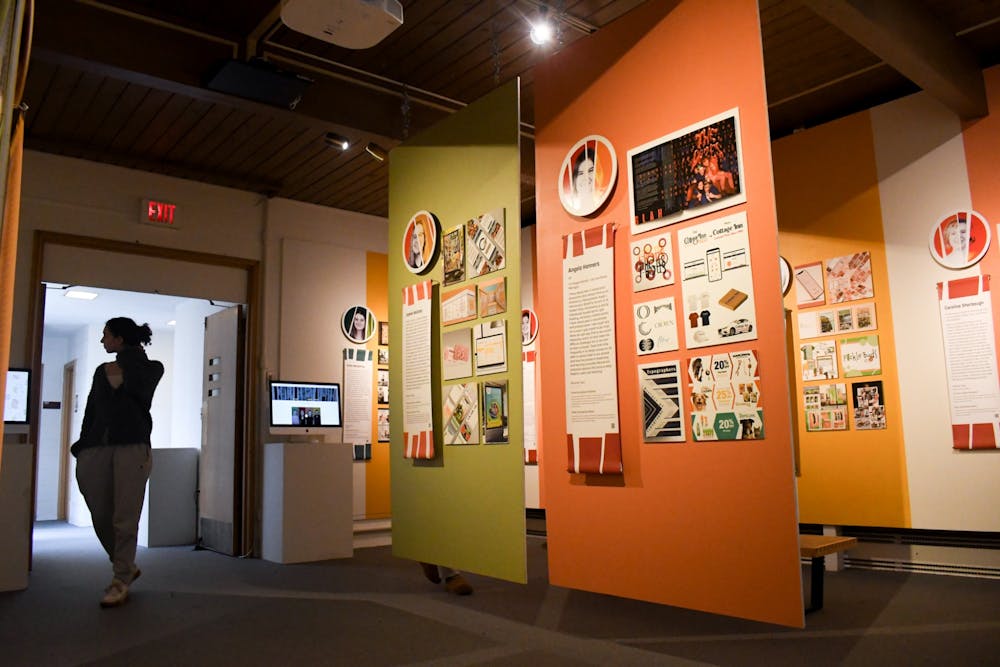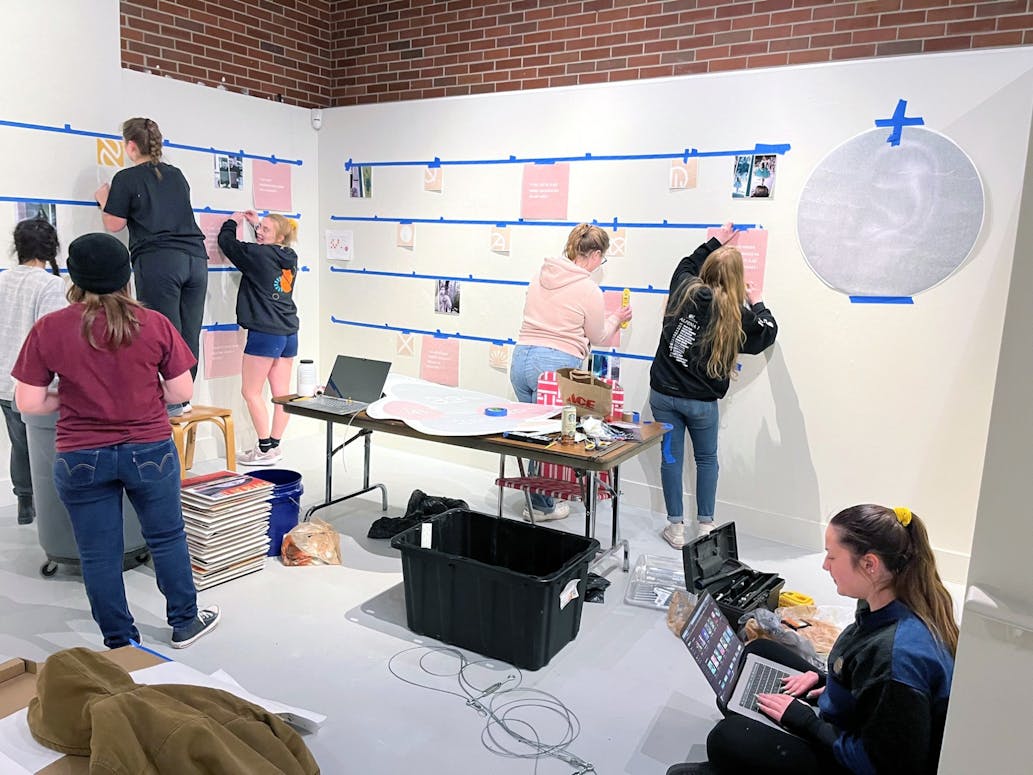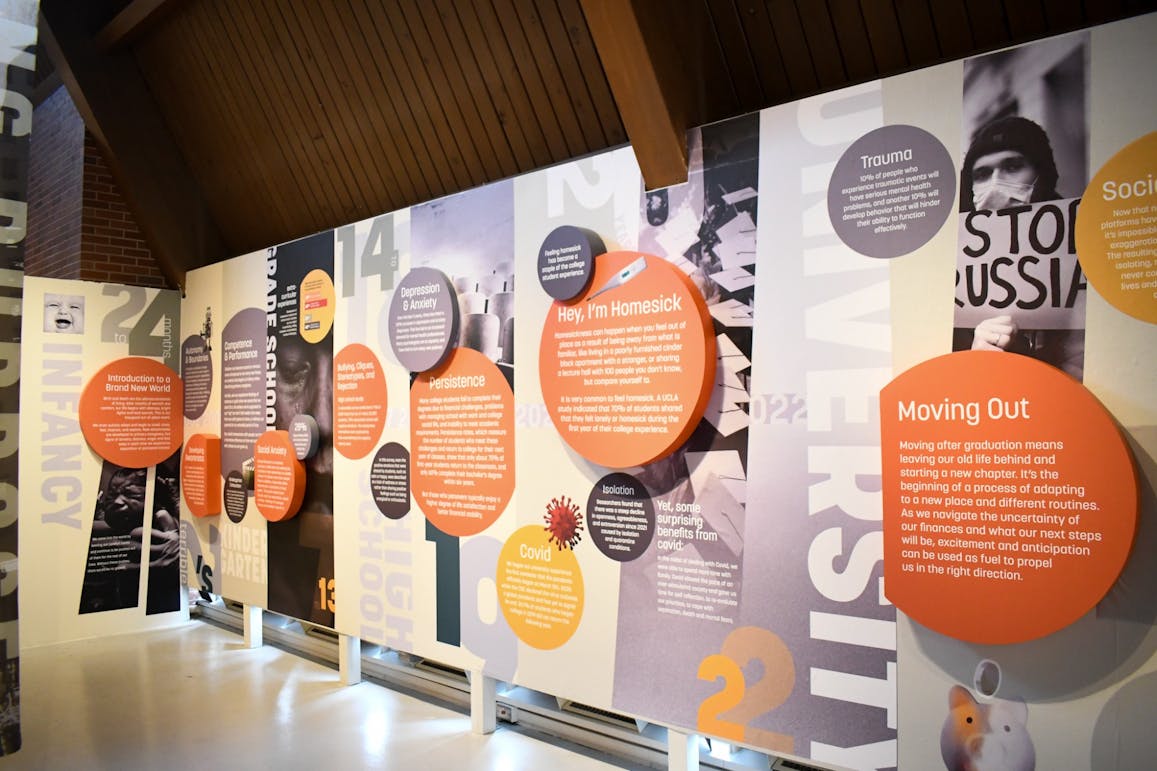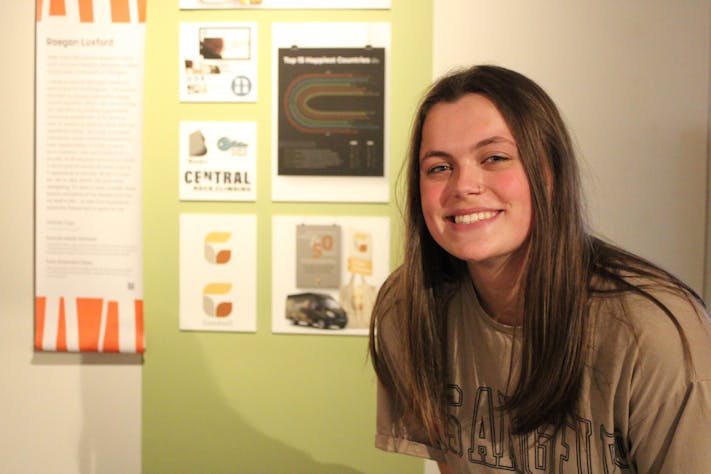Graphic Design Capstone looks at feeling Out of Place in college, workforce
'At some point in life, we’re all going to feel out of place'

Editor's note: Presentation Editor Caroline Sharbaugh was one of the students involved in the graphic design capstone. In no way did this impact the editorial content or visual presentation of this piece.
Imposter syndrome, awkwardness going into a new workplace, attachments and other topics are explored in the Graphic Design capstone class project called “Out of Place.” The exhibition of student-made designs, pictures, videos and student portfolios can be found in the Central Michigan University Art Gallery through April 15.
Clark Most is a CMU faculty member in Art and Design who taught the capstone class, Art472, this spring.
“(Out of Place) topic is something that is extremely relatable, especially to students that are going through … university life. But it doesn’t fall into the category of topics that have a lot of exposure where people are getting tired of it,” Most said.

Clark Most
Courtesy photo | Clark Most
Eighteen students worked on the project: Brett Best, Brianna Dell, Evan Dodge, Eric Estes, Clay Grabow, Jamie Haisma, Angela Hanners, Gloria Heye, Lauren Hunt, Christen Karasinski, Isabel Karnes, Kunyah Li, Raegan Luxford, Quinn McCraffey, Toni Mires, Claudia Persons, Caroline Sharbaugh and Mahogany Wells, according to the CMU website.
What is the Graphic Design capstone project?
CMU’s capstone project is unique in that instead of a regular thesis, students get hands-on experience creating their own designs and exhibition, Most said.
“We’re developing these larger themed exhibits which bridge academia and professional practice by developing research and writing skills, along with processes and design thinking that are critical for graphic designers,” he said.
Students started working on the project last semester when they developing the general aesthetic and concept for the show, Most said. This semester they had 10 weeks to put the exhibit together.
“The timeline was really tight,” Most said. “That was a huge challenge.”
The project is a curated themed show “where all of the students were involved in developing one large concept and cohesive story,” Most said.
Students worked in small teams; each was responsible for their own part, such as research for the exhibit, design work, filming videos, writing and drawing conclusions. Students used motion graphics, developed websites and made a booklet that showcased their portfolios.

Graphic Design Capstone class students build their capstone exhibit in the University Art Gallery.
Courtesy photo | Clark Most

Through their art and design, they talked about imposter syndrome, shared their childhood attachments and explored facets of their college experience, such as COVID-19 pandemic, anxieties and other topics related to the theme.
“Each of the parts of the exhibit serve a different purpose and a different outcome,” Most said.
The idea for the theme was developed by Luxford and Gloria Heye.
“I just really wanted people that were reading wherever in the gallery ... to feel … and really be able to relate to that other people feel this way too, that they’re not alone,” Luxford said. “I feel like a lot of people think that they feel out of place.”
Out of Place theme

Raegen Luxford, senior, poses for a portrait next to her portfolio in the University Art Gallery, on the campus of Central Michigan University, Tuesday, April 12, 2023.
Since some students are graduating this spring, they can relate to the topic, Luxford said.
"At some point in life, we’re all going to feel out of place,” she said.
“'Out of Place' refers to the anxiety that a lot of people feel when they go through transitions, for example, graduation. … But it also applies to other things that people go throughout their lifetime,” Most said.
During the transition from college to workforce — with the challenges of finding an apartment and a job — students might experience this disconnect because they are leaving their attachments, Luxford said.
“I think that most people have a feeling like (imposter syndrome) throughout their life, regardless their position and capability,” Most said. “Every time you make the transition switch to a different job or try something new, you're going to … feel a little bit uneasy about it at that.”
Luxford is from Frankfort, “a small tourist town in the pinky of Michigan,” according to her portfolio in the University Art Gallery. When coming from a small school to a big college like CMU she felt imposter syndrome, Luxford said.
She found graphic design at the end of high school, and her freshman year at CMU she fell in love with it. She said the because she is a “very persistent” person and the professors in the design department were “great,” she was able to overcome her sense of imposter syndrome.
“I love all sorts of the web design aspect, the layout design … everything about it I love,” Luxford said. “I specifically like layout design because I think of it as a puzzle, you have to fit all the pieces in a strict grid structure. … I am a very organized person, so it’s kind of fun for me.”
Luxford also works as a graphic design coordinator at the University Recreation in the Student Activity Center, where she develops posters for activities in SAC, runs social media and makes advertisements. She said she didn’t feel out of place at her work because her boss and co-workers made her feel welcome.
However, now that out of place feeling catches her at home.
“I feel like ever since I left (Frankfort), I have really grown out of that environment,” Luxford said. “Whenever I go back, I feel like I don’t belong anymore.”
The capstone exhibition offers solutions to these problems, as well as touches on tips on developing emotional intelligence, how to have better self-awareness and how to direct feelings into something that propels one forward in life Most said.
“To mitigate the effects of Imposter Syndrome, it is important to explore why we feel and respond the way we do, then take practical steps to control and reframe our thoughts,” according to one capstone caption.
Much of the students' research advised graduates who are feeling out of place after college to accept themselves, be aware that other people are experiencing the same thing and realize that it is OK to make mistakes.
“In the end, many of the things that happen to us we have control over,” Most said. “We ... have control over things if we react to them in the right way.”
Luxford said students should try new things, because this is where they might find their passion and belonging.
“As graphic design majors going into the workforce, we are leaving all things 'home' and familiar,” reads an exhibition caption. “Starting college during the Pandemic disrupted our sense of place as we were forced to teeter between home and an attempt at a normal college experience.
“Feeling Out of Place due to our own place attachments can be frightening, but it can also bring opportunities to form new attachments and experience personal growth.”
The exhibition is open Tuesday through Friday from 11 a.m. to 6 p.m. and Saturday from 11 a.m. to 3 p.m. or by appointment at the University Art Gallery, 251 E. Preston St.
Admission is free and open to public. Tours are available at no cost. To schedule a tour for over 15 people, call 989-774-7457.
The exhibition will close at 3 p.m. Saturday, April 15. It opened April 1.







